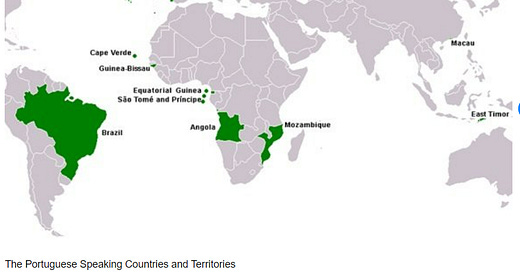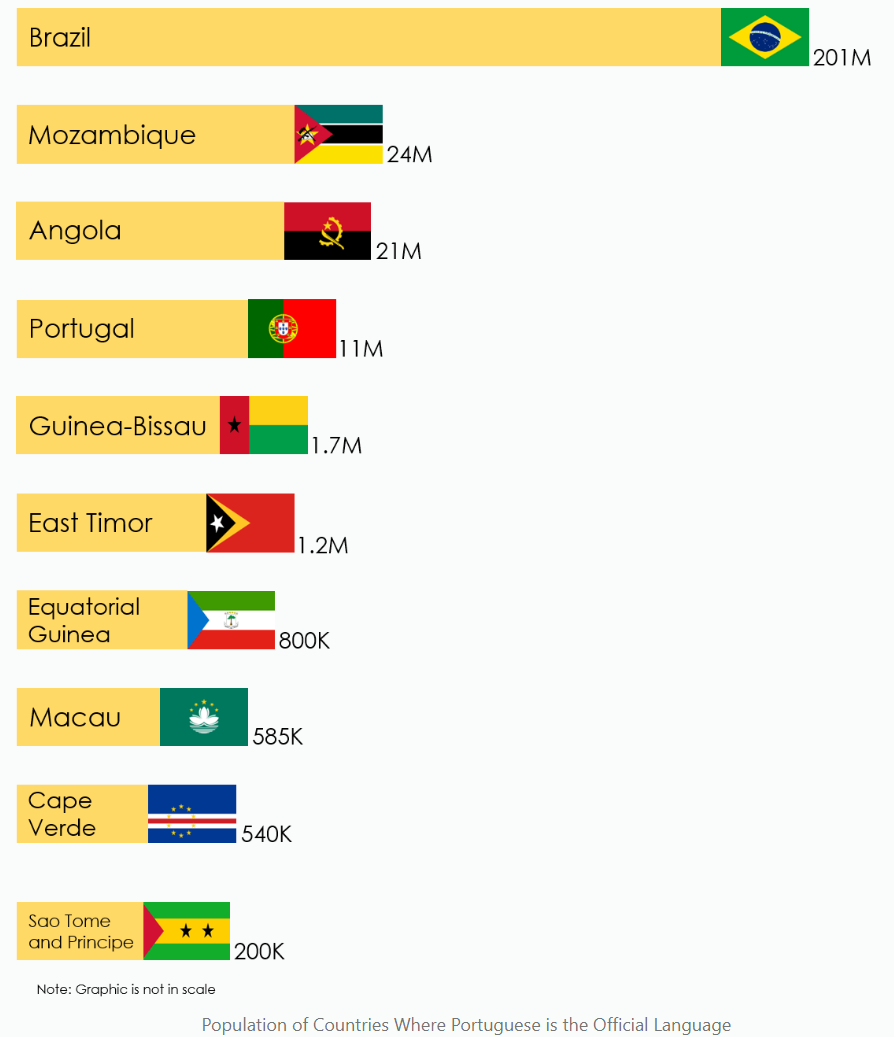So today we'll be adding three letters to the alphabet ...
And other things that happen after language experts collaborate for a decade
We were chatting with a Portuguese friend of ours about Portuguese and had a question about a word. She had to stop and think if that word had changed in the latest update.
ERK? SAY WHAT?
As tiny as Portugal is, it once was the center of global maritime exploration. Consequently, the language was spread throughout the world. While that influence has waned considerably over the centuries, it is still usually listed as the fifth most-spoken language worldwide today with an estimated 260 million people using it everyday.
The vast majority of these speakers are concentrated in nine countries and a territory that list Portuguese as an official language. These are scattered across continents and separated by oceans; a couple are islands unto themselves.

If you take a moment to consider how different English sounds from, say, Alabama to rural Maine, it’s easy to understand how the Portuguese language would change dramatically as each wildly disparate area develops its own customs and norms.1 That’s not even considering both accents and spelling differences between the US and the neighbor cross the pond, or that island down under.
We’ve already touched briefly once or twice on the gap between “Brazilian” and “European” Portuguese. That isn’t going away. But there have been multiple efforts made over the centuries to try and smooth out some of the major differences that have evolved in various places.
Imagine the UK and the US sitting down to agree on the “proper” treatment of the following exchange:
British Bill: I just spotted my favourite footballer in line at the ice cream parlour!
American Adam: Do you mean David Beckham?! Really?! Which shop? The one over toward the elementary school?
BB: Yes to both! He was standing with a 20 pound note in his hand whilst reading the menu.
AA: Wow! He’s been retired for a few years now. How does he look?
BB: He’s not ageing well.
Somehow, it’s hard to see those linguistic negotiations getting embraced with enthusiasm on either side of the Atlantic.
Add in quirks in Portuguese like:
there are five diacritical marks to consider (á, à, ê, ç, and ã)2
because every verb is conjugated for both person and number, there are six different conjugations for each verb tense3
and it seems unfathomable to even try to agree on a common structure for the written language.
But that’s exactly what happened when representatives from the Sciences Academy of Lisbon and the Brazilian Academy of Letters sat down in 1980 to begin negotiations on a treaty that would unify the conventions around writing Portuguese.
You’ll note we said begin negotiations. The reason the somewhat wonkily named Portuguese Language Orthographic Agreement of 1990 includes “1990” in the title is because it took a decade for everyone to finally sign off on the conclusions.4 And by “everyone” we mean the people in the room. The ones who saw how the sausage was made. The language nerds who understood why it made sense to ditch the umlaut (Brazil used ü up until this agreement was adopted) and eliminate the silent letters (the “p” in optimo and the “c” in exactamente weren’t spoken, for example).
The next step was actually making the agreement happen. Which meant that more than 230 million would need to re-learn some aspects of the language they used every day. Some of the changes were almost seismic:
the spellings of 1.6% of European Portuguese and 0.5% of Brazilian Portuguese words were altered7
accents and hyphens were standardized, and the umlaut was dropped from Brazilian Portuguese.
Perhaps the best way to illustrate the challenges involved in implementing this agreement is to re-cast part of the Wikipedia article in timeline form like so:
6 - 12 October 1990: representatives from the following seven of nine Portuguese speaking countries meet in Lisbon to put the finishing touches on the agreement that had been a decade in the making:
Angola
Brazil
Cape Verde
Guinea-Bissau
Mozambique
Portugal
São Tomé and Príncipe8
16 December 1990: representatives officially sign the agreement, passing it along to the respective governments for ratification/adoption.
The agreement itself specified that the changes it called for would take effect on 1 January 1994, giving the governments three years to ratify it.9
23 August 1991: Portuguese government ratifies the agreement
18 April 1995: Brazilian government ratifies the agreement
Cape Verdean government also ratifies the agreement (date not found by us)
17 July 1998: an amendment to the agreement removing the 1 January 1994 deadline for implementation is signed … by the representatives of Brazil, Cape Verde, and Portugal.
June/July 2004: government officials from all nine countries that list Portuguese as an official language meet in São Tomé and Príncipe, to a) add East Timor to the agreement and b) modify the text so that ratification by only three members rather than the entire group would suffice for the agreement to take effect. São Tomé and Príncipe also ratifies the agreement.
To put it another way: the language nerds negotiated for ten years to reach an agreement. They passed that agreement on to the governments, who sat on it for 14 years before agreeing that only three of the governments needed to agree on it for the agreement to take effect.
This is not entirely unlike the United States, Canada, and Mexico all agreeing that Germany and France should adopt a specific policy. One can see where Germany and France might take issue with this course of action.
13 July 2007: government of Equatorial Guinea ratifies the agreement
21 July 2008: Portuguese government passes a law implementing the changes. There is a six-year transition period written into the legislation.
1 January 2009: Brazil officially fully implements the changes specified in the agreement. Though the old spelling rules remain valid until 31 December 2012, Brazilian newspapers and publishing houses are quick to adopt the modifications.
1 January 2012: Portuguese government and official gazette, Diário da República, fully implement the spelling changes
12 May 2015: transition period ends in Portugal. The agreement is now officially the law of the land.
January 2016: transition period ends in Cape Verde
Twelve years after agreeing that the agreement could be implemented even though six of the nine countries covered by the agreement hadn’t agreed to the agreement, the agreement is fully effective in three of the nine countries.
So how did it all work out?
This is a tough question to answer.
Objectively, only Brazil, Cape Verde, and Portugal have fully implemented the agreement leaving nearly 50 million native Portuguese speakers (almost 20% of the population) operating under the pre-agreement conditions.
The agreement was not popular at the time, particularly in Portugal. According to some translators - who had more reason than most to be closely following developments on this front in mid-2009 - “An opinion poll published by Correio da Manhã found that 57.3 per cent of the Portuguese are against the new spelling rules, and 66.3 of them say they are not going to use such new rules.”10
Eight years later, a new generation of children has been educated with the changes - tweens and young teens have been schooled to spell ótimo without a p.
What effect is there on those who had the ground shift under them in the mid-2010s? Hard to say. We do know there may be some readers, though, who have had first hand experience with this. We’d love to hear your thoughts/ anecdotes/ observations. If you’re willing to share them publicly,
If you’d prefer to dialogue in private, feel free to drop us a line.
That’s all for now.
Love from Lisbon,
Scott & Amy
Do you use a drinking fountain, a water fountain, or a bubbler? Do you wear sneakers, tennis shoes, or trainers? Do you eat a sub, grinder, or hoagie? Do you wash it down with a pop, soda, or soft drink? Most of these regionalisms occur within several hundred miles of each other; on the same continent; and, given the subject matter, developed in probably less than 100 years.
Portuguese was recognized as a language in 1290. It’s had some time to evolve.
And there was at least one more prior to this agreement.
this is typical of Romance languages
One wonders what the final sticking points were. Was it the sixth way to pronounce the letter X? And what happened to finally get everyone over the hump? Did they drop a cedilha somewhere in exchange for a spelling change? Details! We want details!
The letters K, W, and Y were added as part of this agreement. Language gets no more basic than the alphabet it depends on. How would you react if you were told that tomorrow, English was adding three new letters to the alphabet?
As foundation-shifting as this change is, it’s almost a no-brainer given how out of step the Portuguese alphabet was to the other Latin-based alphabets worldwide. One can almost see the opening remarks:
“Thank you all for coming to this important conference. I hope your travels were uneventful. Before we begin, can we all just agree straight out that we’re going to add K, W, and Y to the alphabet? Yes? Great! Now let’s roll up our sleeves and get to work.”
Sure hope someone’s developing a screenplay for this. Any Netflix producers out there?
Any native Portuguese over 30 is likely to have trouble spelling some common words that shifted on them.
Compare this to the chart above and you’ll notice there was no representation from East Timor (which was under Indonesian occupation at the time), Macau (a region of China, not an independent state), or Equatorial Guinea. Right out of the gate, then, more than 2.5 million native speakers of the language aren’t represented.
The agreement also specified that it would only take effect after it had been ratified by every country. Oh those optimistic word nerds!
Amusing that 9 percent of those polled weren’t against the rules per se, they merely had no intentions of following them.






There is something interesting about two countries with different word pronunciations trying to impose the same spelling AND insisting that be phonetic. I finally learned last year that the reason English spelling is the way it is, is that all languages periodically go through episodes of rapid--rapid as in a century--pronunciation change, and English had the bad luck to be going through one at the exact time that printing was being introduced, so printing "froze" a bunch of inconsistent and different pronunciations.
I don't think there's anything so remarkable about "five different ways to pronounce the letter 'X'".
There are certainly at least six different COMMON ways to pronounce the sequence "-ough" in US English: borough (usually pronounced as a schwa), bough, cough, dough, tough, through. Two more in British English: hiccough, and lough.
WE have at least four ways for X ourselves. The common one is of course "ks" as in "lax," but it is pronounced like Z in "xylophone." Thus X is pronounced two different ways in the same name "Xerxes." Some times it's pronounced like "ks," but sometimes like "kz" as in "exaggerate" and "exam." And it can be silent at the end of a word, as in "faux." Imagine saying "Max Versatappen just won the grand pricks." I honestly am not sure how to pronounce "beaux arts" or whether that counts as English, but that would get us up to five and just as confusing Portuguese.